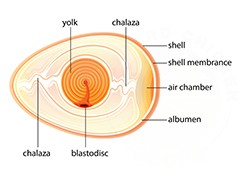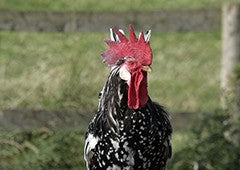Chickens are busy little creatures! And, since they spend the greater part of every day on their feet, you’d pretty much egg-spect to see them relaxing each evening with their weary feet propped up on a hay bale. Not a chance! The typical backyard flock of chickens can and will be seen roaming their backyard foraging until the very last hint of sunlight quietly disappears over the horizon. Enter their indomitable innate desire to roost. Certainly, no rest for the weary feet of a happy chook! So, is it any wonder that their fabulously faithful little feet sometimes succumb to a sore spot every now and then?
Because a chicken’s feet bear the entire brunt of their flurry of activity from sun up to sun down it’s especially important to keep their fabulous feet fantastically fit!
Happy Healthy Chicken Feet Don’t Miss a Beat!
Healthy chicken feet are for the most part smooth and soft with a rubbery feel. While scales do cover the tops of a chicken’s toes, their feet are still soft and sweet! Despite this soft -like exterior, a chicken’s foot is actually made up of sixteen bones that work together and flex for superior balance and movement. Generally, chickens have three forward facing toes and one hind toe for egg-stra balancing stamina, with the egg-ception of breeds like the Silkies, Dorkings and Faverolles which have four forward facing toes. A little background egg-splanation goes a long way-knowledge is a powerful tool in keeping your flock healthy!
Equipped with these awesome, made- to- move and grasp feet, is it any wonder that busy little chicken feet need a little TLC sometimes. After all, chicken feet are on the clock 24/7 as they wander, forage, jump and land, fly the friendly skies with their airborne bird, flop around in a dust bath, nest, and grasp their roost from sundown until sun up when they awake to do it all again. Chicken feet really don’t miss a beat!
What is Bumblefoot?
Bumblefoot is basically an infection caused by the staphylococcus bacteria which enters the chicken’s system through a cut, scratch, injury or a chafed and irritated area on its foot. The infection creates an abscess full of pus. It affects all species of poultry and occurs worldwide. Since this infection is quite common among backyard chicken flocks, you may discover that something “fowl” is afoot while visiting your chooks one day. But, don’t retreat, treat!
Symptoms of Bumblefoot
First things first-is it really Bumblefoot? Your strong winged wonders can and do flap themselves up and down and here and there throughout the day. Their naturally curious nature takes them to places that they should and should not be- when you march to the beat of chicken feet you could end up just about anywhere. From fence posts, tractors and hay wagons to dog houses, decks and laundry line posts, your clucky chooks will inevitably investigate. And, what flaps up, needs to flap back down-landings such as these from precarious heights and/or onto rough surfaces can lead to injury. So, if you notice a chook or two limping or favoring a particular leg, it may not necessarily be Bumblefoot, but rather, due to a rough landing. Either way, it warrants closer observation.
Because Bumblefoot mimics a typical foot or leg strain or injury, one of the first signs of this condition is limping. Chickens that have Bumblefoot will limp and sit or rest more often than usual to avoid pain. Chooks may not want to roost and opt for sleeping on the ground instead. Another telltale sign is swelling of the joints in the toes and foot in general.
Basically, Bumblefoot develops in three distinct stages, with each stage being more serious than the previous.
Stage 1:
The first stage of Bumblefoot is characterized by pinkish- red rough areas on the top or bottom of the chicken’s feet or between its toes.
Stage 2:
The second stage manifests itself with increased redness, sores, inflammation and infection. The chicken in question will most likely be feeling a little pain upon walking and landing.
Stage 3:
During stage three, the final and most serious stage of this infection, any sore that has not been treated will turn dark brown-ish black. Chickens are in a good deal of pain and will avoid any movement or activity that puts pressure on their sore weak foot or feet.
Who Gets Bumblefoot?
Now, while Bumblefoot affects all breeds of chickens, heavier breeds and males are definitely more susceptible due to the pressure that the extra body weight exerts on their foot pads. That being said, any overweight bird can be more prone to a Bumblefoot infection, as well.
In addition to weight, this type of infection can also be attributed to nutritional deficiencies, too much protein in your flock’s diet, as well as, an excessive amount of uric acid in their system. A healthy balanced diet = healthy happy chickens who are less likely to develop infections. Chickens who do not get enough vitamins A and B or who get too much protein are more likely to get infections. Normally, a chicken’s body excretes any excess uric acid, a waste product; however, individual genetics, a digestive system malfunction, recurring illness and infections, an unbalanced diet, sedentary chooks or a wet and/or soiled environment can cause the uric acid to remain in the chicken’s bloodstream.
If you do discover a chook with a Bumblefoot infection, you should do a quick check of all your chooks’ feet just in case. It’s always better to be safe than sorry, because in the wonderful yet wacky world of chickens, we backyard chicken keepers know very well that ,while out and about, chooks often don their monkey suits and play the delightful game of monkey see, monkey do! Curious chickens follow other curious chickens.
What Causes Bumblefoot?
Simply put, Bumblefoot is caused when the staphalococcus bacteria enters a chicken’s body through an opening or weakened area on the bird’s foot. Because this type of bacteria is soil borne, it is typically prevalent in and around chicken coops, backyards and farm yards. Frequently, unsuspecting chickens will pick it up on their feet and spread it to roosts, swings, nesting boxes and just about anything they flap onto or into. So, when active scratch-y chooks get scratches on their feet, it can be a welcome mat for bacteria to enter! Chickens can develop scratches and cuts on their feet for several reasons:
- Jumping down from roosts that are too high
- Jumping down onto hard packed down bedding, rocky areas or rough ground
- Getting splinters from rough roosts
- Getting injured from nail trimming accidents
- Walking around on wet, soiled bedding for prolonged periods of time
Then, the stapholococcus bacteria invades the open wound and brings about infection. So, put out the “No Vacancy” sign on your chicken coop and keep unwanted bacteria at bay by being proactive. Put preventive measures into action so your chooks don’t get a reaction!

Preventive Measures
- Roosts should be rounded, free of splintery rough spots, and located approximately 40 -46 cm high.
- Keep the chicken coop bedding as clean and dry as possible.
- Feed your flock of fine feathery friends a balanced diet appropriate for their age and stage of development.
- Treat your flock to healthy treats such as a variety of greens, fruits and berries and fresh veggies from the garden and limit starchy favorites like bread and pasta.
- Regularly and thoroughly inspect your free ranging area for sharp objects and rough or rocky areas that could potentially harm busy little chicken feet.
- Perform regular check-ups on your Corps D’elite chicken feet !
Treating Bumblefoot
If you discover a Bumblefoot infection beginning in one or more of your chooks, don’t be alarmed. The beginning stages of this infection can be easily treated. Simply fill a basin with warm water and Epsom Salts and soak the infected foot. Gently dry the foot completely and slather on honey, which acts as an antibacterial, antifungal and antiseptic all in one, non-toxic Nu-Stock (available online and safe for all animals, too) or spray with Vetericyn, cover with gauze and wrap with vet wrap to secure the bandage and keep curious chicken beaks away. You can also provide a little TLC and bring the hen inside in a crate for some egg-stra lovin’ and attention and so you can keep an eye on the recovery process. If, however, your chook shows no sign of improvement after a few days, you may want to consult your local vet.
If the Bumblefoot infection is in the final stages, and you can see a dark scab, you can opt to perform surgery at home or seek out an experienced avian veterinarian. Surgery is definitely a two person procedure and though not complicated, it can prove daunting to a humble backyard chicken keeper. Surgery basically consists of using a scalpel or biopsy punch to cut out the scab and remove the underlying infected core which may or may not have become hardened. Sometimes this core is attached to the scab making it a bit easier to remove. Then, drain any pus and treat the wound as stated above. If you do choose to take the surgery route, you can simply google this procedure and find detailed descriptions accompanied by photos or videos to walk you through.
If left untreated, Bumblefoot can spread up the leg and into other tissues and bone. Ultimately, this will lead to permanent lameness or even death. So, while this infection is easy to recognize and treat with home care if caught early, if you notice something that “just isn’t right” on your chooks’ feet, don’t hesitate to seek professional help.
From bumblefoot to sour crop, we chicken keepers want to do an eggcellent job when caring for our feathered friends. To prevent and identify health concerns in your chooks, make sure that you've got the knowledge you need to raise happy, healthy chooks. Did you know 67% of chicken keepers surveyed experienced a chicken health or behaviour issue in the first 12 months that they didn’t know how to handle?
But don’t worry! Our feathered friends over at Chickenpedia have created a Chicken Healthcare Course. It is a comprehensive online course that covers everything you need, including what to look for in an unhealthy chicken and how to support your egg-laying hens to optimal health. All of their courses are really well structured and filled with vital information, which is why I highly recommend them to all of my readers! From raising baby chicks to feeding to behavior, you’ll find valuable information that’ll give you the knowledge and confidence to successfully look after your chickens.
Check out Chickenpedia today and as a member, you will also get access to the ALL of their chicken courses!



















